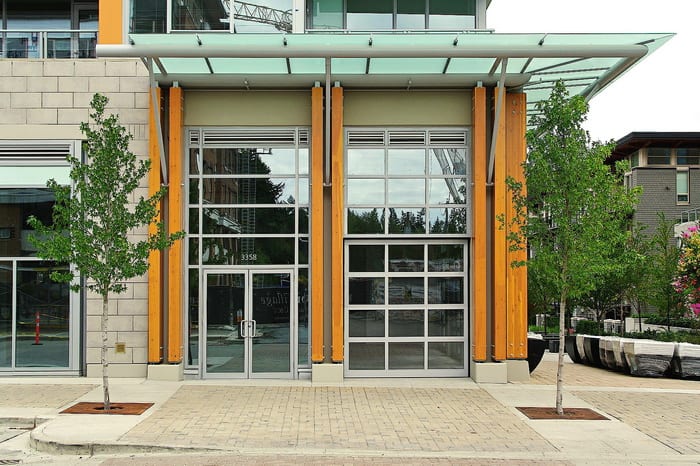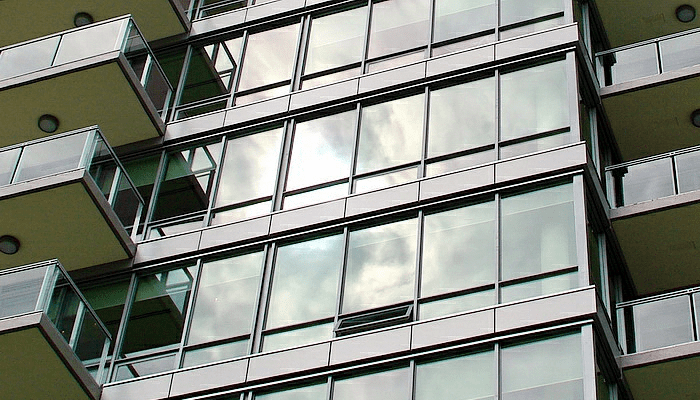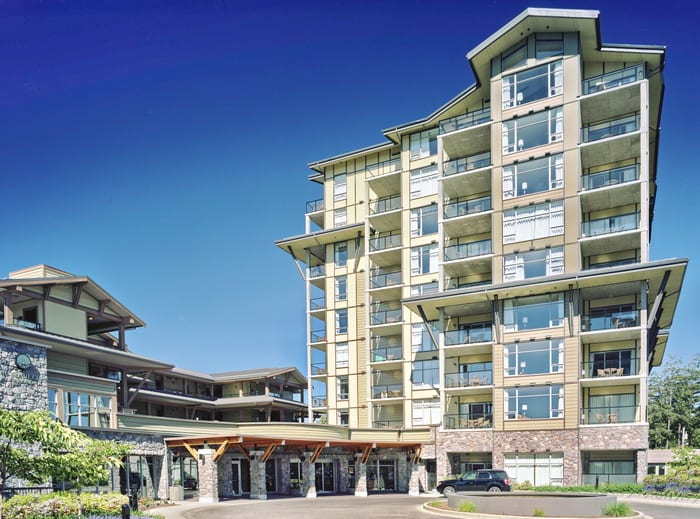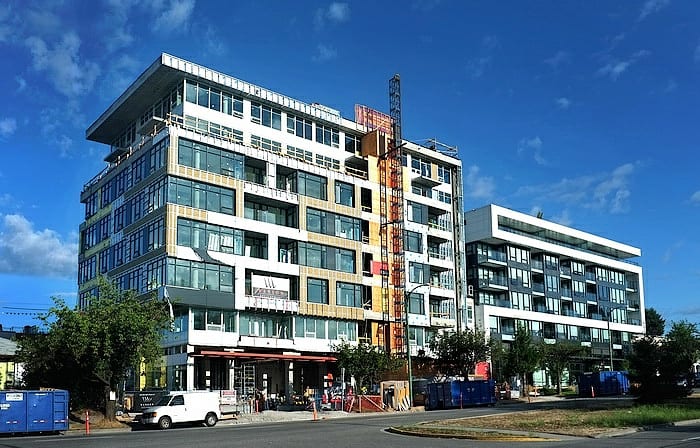In Part 9 of the National Building Code we see an explicit distinction between two types of fenestration products.
“Manufactured and Pre-Assembled” products have their performance evaluated by testing to NAFS and the Canadian Supplement (Subsection 9.7.4). “Site-Built” products have their performance evaluated under Part 5 (Subsection 9.7.5).

Products Outside Scope of NAFS
Subsection 9.7.4 limits the application of NAFS and the Canadian Supplement exclusively to “manufactured” fenestration products within the scope of NAFS. (So does Part 5, see Clause 5.10.2.3.(1)(b).) The use of the term “manufactured” in 9.7.4 suggests that these products are fully assembled, including the installation of glass, and require no additional work to complete the manufacturing at the jobsite.
NAFS however does not make an explicit distinction between “manufactured” and “site-built”, and most AW class products are typically site glazed. The distinction is made by the Code in Subsection 9.7.5, which identifies products outside the scope of NAFS as “site-built” products.
Why is this distinction important? Because the Code expects products within the scope of NAFS to be tested to NAFS and the Canadian Supplement. It requires products outside the scope of NAFS to “conform to Part 5”.
In this article, all references to NAFS are to to the 2008 edition, also indicated as NAFS-08.
So What are the Products Outside the Scope of NAFS?
The list of products that are outside the scope of NAFS-08 is presented at the end of Clause 1 of the standard. Since many readers of this blog may not have access to the standard, the list is reproduced below:
“Fenestration products not intended to be tested to this Standard/Specification include:
(a) Interior windows and doors;
(b) Vehicular-access doors (garage doors) (see ANSI/DASMA 105, ANSI/DASMA 108, ANSI/DASMA 109, ANSI/DASMA 115, or other applicable DASMA Specifications);
(c) Sloped glazing (other than unit skylights or roof windows) (see AAMA TIR A7);
(d) Curtain wall and storefront (see AAMA MCWM-1);
(e) Storm windows and doors (except when incorporated in dual windows and dual doors) (see AAMA 1002.10, AAMA 1003, and AAMA 1102.7);
(f) Commercial entrance systems (see AAMA SFM-1);
(g) Sunrooms (see AAMA/NPEA/NSA 2100);
(h) Revolving doors;
(i) Site-built door systems; and
(j) Commercial steel doors rated per SDI A250.8.”
Note that with only a few exceptions (interior windows and doors, revolving doors, and site-built door systems), products outside the scope of NAFS are excluded with reference to other standards, technical guides or design manuals that pertain specifically to those products. To the extent the provisions of these American documents are applicable to Canada, they could be utilized by registered professionals to design products for conformance to Part 5 fenestration requirements.
(NAFS-11 adds one more item to the list of excluded products: folding door systems. However a number of Canadian folding door manufacturers have tested and certified their products to NAFS-08, and efforts are underway to amend NAFS-11 to remove folding door systems from the list of excluded products. For more information, see the blog article titled NAFS and Folding Doors.)
What Products are Inside the Scope of NAFS?
Is there a similar complete list of products that are within the scope of NAFS? Not exactly.
NAFS Clause 1, titled Scope, says “This fenestration Standard/Specification applies to both operating and fixed, prime and replacement windows, doors, TDDs, and unit skylights installed into exterior building envelopes.” As such NAFS is inclusive of all fenestration products except those explicitly identified as being outside its scope.
Of all the products within the scope of NAFS, the thirty most common have Performance Class definitions in NAFS-08. These products are listed in Clause 4.4.2, Table 5, titled Product Types, and are summarized in list form below:
Window Products (17)
AP Awning, hopper, or projected window
BW Basement window
C Casement window
DAW Dual-action window
FW Fixed window
GH Greenhouse window
H Hung window
HE Hinged rescue window
HP Horizontally pivoted window
HS Horizontal sliding window
J Jalousie window
JA Jal-awning window
SHW Side-hinged (inswinging) window
TA Tropical awning window
TH Top-hinged window
VP Vertically pivoted window
VS Vertical sliding window
Door Products (9)
ATD Architectural terrace door
DASHD Dual-action side-hinged door
FD Fixed door
LW DASHD Limited water dual-action side-hinged door
LW SHD Limited water side-hinged door
SD Sliding door
SHD Side-hinged door
SLT Side lite
TR Transom
Skylight Products (4)
RW Roof window
SKG Unit skylight — glass glazed
SKP Unit skylight — plastic glazed
TDD Tubular daylighting device
Other Products
SP Specialty product
NAFS is inclusive of all fenestration products except those explicitly identified as being outside its scope.
What are Specialty Products?
Specialty products are products that are legitimately within the scope of NAFS but are not listed by name in Table 5 of NAFS-08 (summarized in the list above). Specialty Products can be tested for Performance Grade but cannot be assigned to a Performance Class because NAFS does not provide product-specific Class requirements for them. On product labels, they are designated with the abbreviation SP.
NAFS Clause 8.4.1 defines Specialty products in this way:
“Specialty products are defined as primary windows, doors, or unit skylights of a type not [listed in Table 5]. . . . Specialty products shall comply with all applicable material, component, and hardware requirements of this Standard/Specification . . .”
“Specialty products . . . shall not be assigned a performance class designation. For example, the primary designator for a specialty product with a tested size of 1016 × 762 mm (40 × 30 in) that qualifies for performance grade (PG) 40 shall be “SP – PG40 1016 × 762” or any allowable variation thereof as described in Clause 4.4.2.”
The Specialty product category is intended to allow for newly developed products as well as products that are not used widely enough to have Performance Class definitions in the Standard. It requires such products to conform to NAFS in all applicable respects, and allows them to be tested and labeled with Performance Grades in the same way as products that do have defined Performance Class requirements.

Example of Window Wall. Photo: Al Jaugelis
Common Products Not Named in NAFS-08
There are several products widely used in Canada that are not specifically named in NAFS, such as window wall, a type of factory glazed window most commonly used in mid and high rise multifamily buildings, and folding doors (also called bi-folding or accordion doors).
Window wall products, while not named in NAFS-08, are factory glazed windows typically spanning from slab to slab. In NAFS-11 they are mentioned as a type of mulled window. Several BC window wall manufacturers have tested their products as windows under NAFS-08.
Folding doors have features in common with side hinged doors as well as sliding doors. As folding doors by their nature and large size require some amount of site assembly, some argue they are “site-built door systems” that are outside the scope of NAFS. However since NAFS does not explicitly exclude them, nor does it exclude site-built products in general, they can legitimately be considered within the scope of NAFS. Several Canadian manufacturers of folding doors have tested their folding door products as Specialty Products under NAFS. Some of these manufacturers are located in BC.
From a Code compliance standpoint both of these products could be considered as products within the scope of NAFS and qualified on the basis of NAFS testing and labeling. As they are not named within NAFS, I can see why some people would conclude they are outside the scope of NAFS, and why those people would maintain they are “site-built” products that have to demonstrate compliance with Part 5 requirements on the basis of professional design and field review.
With respect to disputes over whether products are subject to comply with the Code on the basis of NAFS testing and labeling, or on the basis of professional design to Part 5, there are good reasons to allow both options.
Handling Disputes over Products Outside the Scope of NAFS
With respect to disputes over whether products should comply with the Code on the basis of NAFS testing and labeling, or on the basis of professional design to Part 5, there are good reasons to allow both options.
Those manufacturers who have in good faith elected to test their products to NAFS have done so to eliminate obstacles to acceptance by building officials and by the market. In the case of Window Wall, by considering the product to be a type of Fixed or Composite Unit mulled window product recognized within NAFS, and in the case of Folding Doors, as a Specialty Product.
There are also manufacturers who have, in good faith, elected to consider their products to be site-built. This does not exempt them from having to demonstrate compliance with the air-water-structural requirements of Part 5. Indeed, choosing the Part 5 route requires costly engineering and often jobsite testing of installed products for air and water-tightness. Part 5 design is always an option in the Code, and should be accepted when the manufacturer can present evidence of professional design and review.
Then there are those who consider the term “curtain wall” to be a product application and not a product type. Such folks argue that a punched opening window framed from curtain wall material is still a window and should be NAFS tested and labeled. I would direct these individuals to carefully consider the language of NAFS: it deals with product types, not product applications. Both the list of “products not intended to be tested to this Standard/Specification”, and the list of “Product Types” in NAFS-08 Table 5 are clear: the standard is dealing with product types, and not their specific application on a particular building.
Whenever there is dispute as to whether a particular product by its very nature or its size and particular installation conditions should be subject to NAFS, building officials should be prepared to accept Part 5 design by registered professionals as an equally valid way to demonstrate air-water-structural code compliance.
And how does Part 5 design differ from NAFS testing? Stay tuned, we’ll take a close look at that in an upcoming post.


